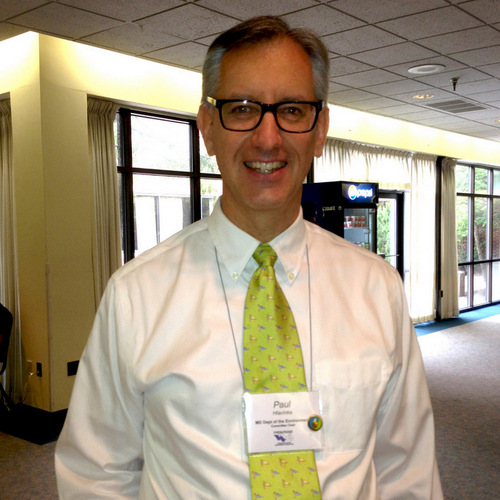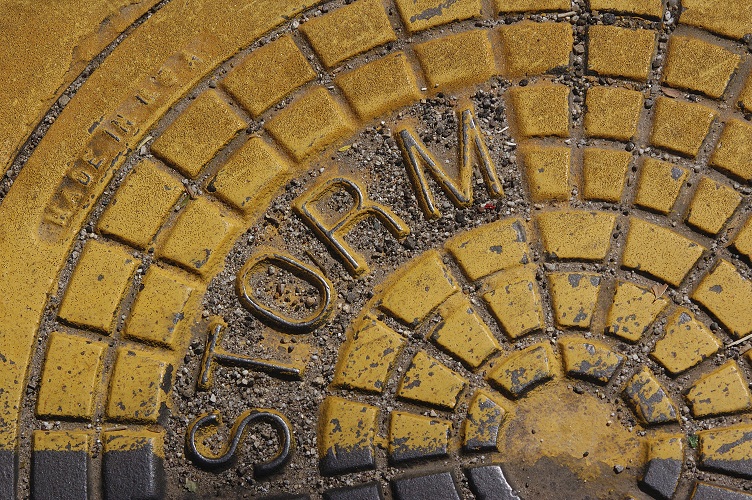
Paul Hlavinka wins the first-ever Golden Rain Drop Award from the Chesapeake Water Environment Association. The pin happens to match his tie.
The Chesapeake Water Environment Association (CWEA) awarded Paul Hlavinka, current chair of the CWEA Stormwater Group, the first-ever Golden Rain Drop Award at its spring meeting, Stormwater 2013: Implementation Realities. The award is for his extraordinary service to the water sector and his advancement of stormwater management.
Hlavinka has a strong engineering and project management background. He received his B.S. degree in electrical engineering from North Dakota State University. He worked with design of data acquisition systems for the automotive industry and served on the Equipment and Tool Institute Standards Committee, implementing U.S. Environmental Protection Agency standards for vehicle inspection and maintenance.
As a project manager, he deployed supervisory control and data acquisition systems (SCADA) for a water utility and a consolidated animal-feeding operation. His passion to improve the health of Chesapeake Bay led him to pursue an M.E. degree in environmental engineering from the University of Maryland–College Park. He is the current chair of the CWEA Stormwater Group and works for the State of Maryland as a compliance engineer.
Stormwater Report – What would you say is currently one of the most important stormwater issues in your state?
Hlavinka – Continuing to find effective, innovative ways to address the impacts of runoff associated with existing impervious surfaces.
Stormwater Report – How did you become a stormwater professional?
Hlavinka – I have always had an interest in our society’s impact on the natural environment surrounding us. My family moved to the Chesapeake Bay region 15 years ago. We enjoy sailing on the bay and, as a result, became concerned with the health of the Chesapeake. We learned about the causes of degradation in the bay and involved our children in projects, such as growing and planting submerged underwater vegetation, raising oysters, and planting tree buffers.
In 2007, I made a decision to change my career path and commit my life work to make a difference. I was already involved in communication systems for water resources and animal-feeding operations. I began a master’s program through the University of Maryland in environmental engineering and studied wastewater treatment, with an additional set of coursework in geographic information systems (GIS).
As I worked through the program, I became very interested in stormwater. I began volunteering for local efforts in Montgomery County (Md.) and helped to start a local watershed group called the Muddy Branch Alliance. We worked closely with another group called Stormwater Partners to provide input and support to the county’s municipal separate storm sewer system permit. I also volunteered with the CWEA in their efforts to address stormwater. In 2009, I graduated and applied to the Maryland Department of the Environment, amongst other organizations, and found professional employment in this field.

Hlavinka’s passion for the water environment led him to seek professional employment in the water sector.
Stormwater Report – Of the stormwater programs and projects that you have participated in during your career, which have you enjoyed most?
Hlavinka – I really enjoy implementing and monitoring projects. One of the first projects I was involved in was a project in the City of Edmonston (Md.). At the time, they were working on several green street projects. I was on a team that designed a bioretention facility. That was a great experience to be part of their efforts to address significant stormwater issues within the city. I get a lot of enjoyment going back to this and other early projects to see them in action while it is really raining. There are few professions where you can truly love seeing it rain.
Stormwater Report – What words of advice do you have for future stormwater professionals?
Hlavinka – Get involved in your community to implement rain gardens, conservation landscaping, and rain barrels. Many people are interested in these fairly simple projects and just need a little help to get there. You would be amazed how many rain barrels are in people’s garages because the homeowner just doesn’t know how to hook it up. Volunteer with watershed groups to create demonstration projects at schools or places of worship so that people can see them in action. If you consider the task in front of us, to really address large-scale stormwater issues, it is going to take thousands of households to implement these measures to start to make a difference. These projects are very valuable for both the environment and for building your résumé. Young professionals should also network with other professionals in organizations such as the Water Environment Federation or Engineers Without Borders.




